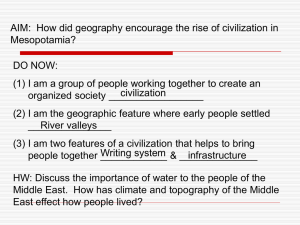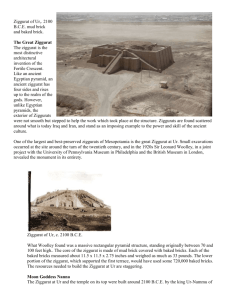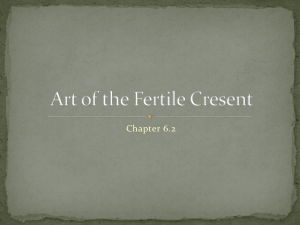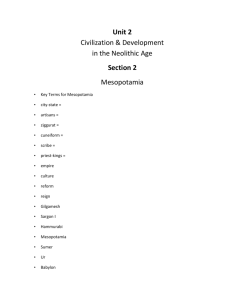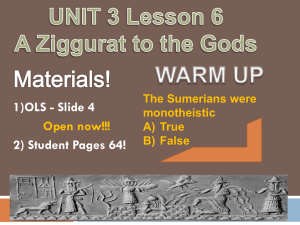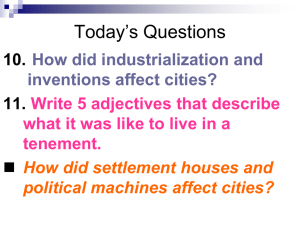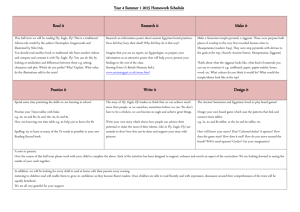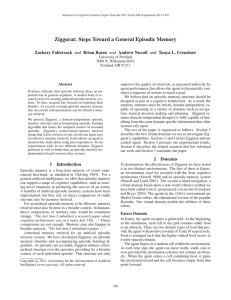Arch 1 Chapter 3
advertisement
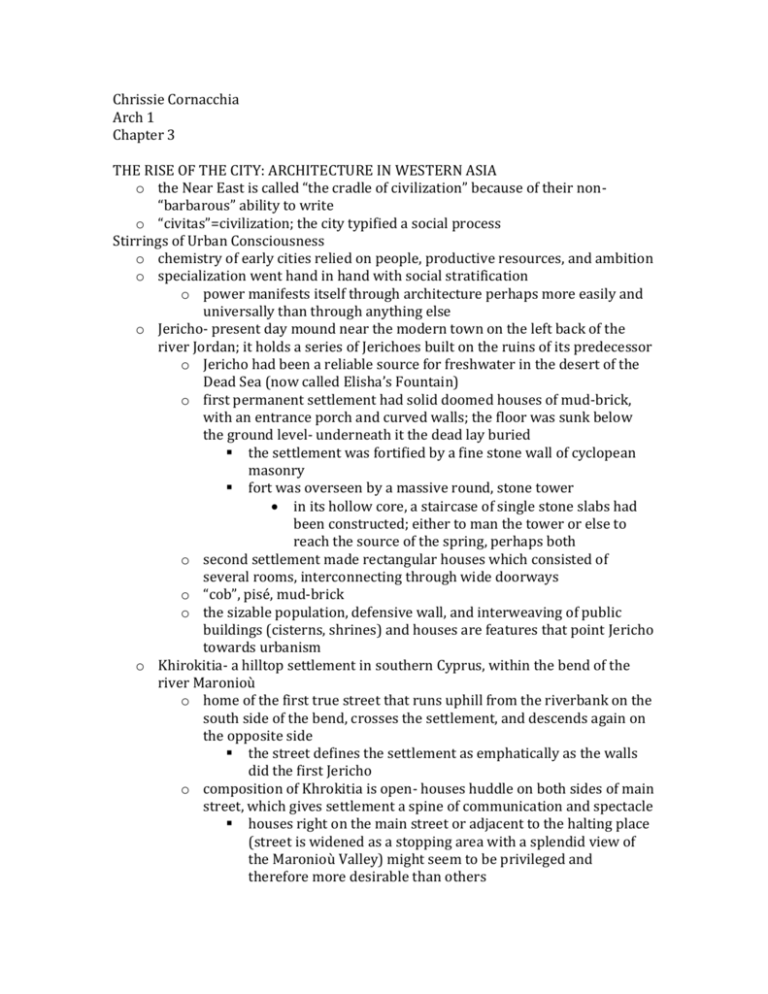
Chrissie Cornacchia Arch 1 Chapter 3 THE RISE OF THE CITY: ARCHITECTURE IN WESTERN ASIA o the Near East is called “the cradle of civilization” because of their non“barbarous” ability to write o “civitas”=civilization; the city typified a social process Stirrings of Urban Consciousness o chemistry of early cities relied on people, productive resources, and ambition o specialization went hand in hand with social stratification o power manifests itself through architecture perhaps more easily and universally than through anything else o Jericho- present day mound near the modern town on the left back of the river Jordan; it holds a series of Jerichoes built on the ruins of its predecessor o Jericho had been a reliable source for freshwater in the desert of the Dead Sea (now called Elisha’s Fountain) o first permanent settlement had solid doomed houses of mud-brick, with an entrance porch and curved walls; the floor was sunk below the ground level- underneath it the dead lay buried the settlement was fortified by a fine stone wall of cyclopean masonry fort was overseen by a massive round, stone tower in its hollow core, a staircase of single stone slabs had been constructed; either to man the tower or else to reach the source of the spring, perhaps both o second settlement made rectangular houses which consisted of several rooms, interconnecting through wide doorways o “cob”, pisé, mud-brick o the sizable population, defensive wall, and interweaving of public buildings (cisterns, shrines) and houses are features that point Jericho towards urbanism o Khirokitia- a hilltop settlement in southern Cyprus, within the bend of the river Maronioù o home of the first true street that runs uphill from the riverbank on the south side of the bend, crosses the settlement, and descends again on the opposite side the street defines the settlement as emphatically as the walls did the first Jericho o composition of Khrokitia is open- houses huddle on both sides of main street, which gives settlement a spine of communication and spectacle houses right on the main street or adjacent to the halting place (street is widened as a stopping area with a splendid view of the Maronioù Valley) might seem to be privileged and therefore more desirable than others o Çatalhöyük- in the Konya Plain of south Anatolia; largest and mot complex Neolithic settlement because of trade o this town of perhaps 10,000 people would seem to have controlled the trade of a valued commodity, obsidian (black volcanic glass used for making cutting tools) o prospecting and metallurgy were two important skills of the town o buildings were grouped into tight quarters so that a continuous, blank was off construction faced the countryside o streets were unknown; quarter opened up to an occasional courtyard o a timber framework of posts and beams divides the walls into a series of vertical and horizontal panels that are then filled with mud-brick and plastered The Cities of Mesopotamia o the “land between two rivers” ; concentrated urban culture sustained by written tradition o 1. Protoliterate Period- towns acquired battlements of ringwalls; the temple and the ziggurat begin to gain architectural definition o 2. Early Dynastic- kingship, first elective then hereditary, became established; monumental palace rose as an administrative center o 3. later Sumerian period- the rise of empire, the collective rule of several citystates through the might of a sovereign king o 4. Assyrian period- Assyrians were known for their imposing state reliefs and their palaces; northern region of the two rivers now flourishes at the expense of lower Mesopotamia o The Layout of the Cities: cities were enclosed by a wall and surrounded by suburban villages and hamlets o two monumental centers were the ziggurat complex and the palace o bazaar (at Ur)- a concentration of little booths along a narrow passage with doors at either end that were closed at night (a market?) o streets were no wider than 9 ft; bordered with houses of the rich, the poorer folk lived at the back along narrow lanes and alleys o houses were rectangular, divided into orthogonal rooms around a central living space o Temples and Ziggurats: these shrines had become monumental temple forms and fitted into the urban scheme o (Warka)- four corners point toward the main directions of the compass, the standard orientation for religious architecture o ziggurat was conceived as a substantial mountain called by the Sumerians, “House of the Mountain, Mountain of the Storm, Bond between Heaven and Earth” the essence of the ziggurat is that it be high; at its skirts will be arrayed the full panoply of theocratic socialism ziggurat is a ladder, as much for the deity’s descent into the city as for the ceremonious climb of human servants permission to build the temple came from above; precise measurements were spoken to the king in secret most famous is ziggurat of Ur-Nammu at Ur; stepped pyramid in three stages none of the lines of the ziggurat is straight; sloping walls are slightly convex- intended to correct the look of stiffness once the ziggurat is built, the remaining question was Would the god be pleased with it and come to reside there? the hope is rigorously upheld ritual o Palaces: Mari- 260 rooms, overwhelms ziggurat complex to southeast the movement of servants and troups must be kept separate from the royal path; the kings intimate life must be separate from his public presence the palace at Khorsabad the Throne Room is a fitting testimonial to the warlike Assyrian kings who had ruthlessly forged an empire out of the city-states of Mesopotamia and struck terror among neighboring people palace grew at the expense of the ziggurat it started out as into a theater of absolute power and intimidation, the symbol of a city whose piety now existed in the shadow of a fierce war machine
